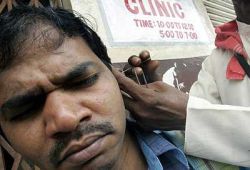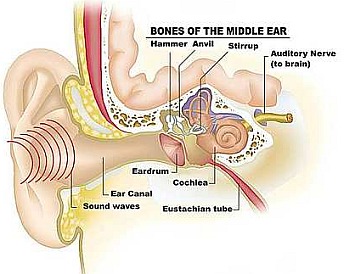 |

Looking after your ears
Sunday October 2, 2005
BY Dr PREPAGERAN NARAYANAN
|
 |
MUCH has been written and said about eye and vision care, but unfortunately, ear and hearing are often neglected.
We have to remember that hearing is an important aspect of daily living, and ear health is part and parcel of overall health. Taking care of the ears can be conveniently divided into five basic but important factors:
Ear wax
In ideal situations, ears take care of themselves. The ear is normally a self-cleaning organ. A normal amount of wax is secreted by the outer ear to protect the eardrum from dust and dirt. Wax acts in a protective manner, catching particles that may land in the ear. Fine hairs inside the ear canal constantly move wax and sloughed skin out of the canal.
Wax and skin can build up inside the ear canal. If the canal is not clean, the eardrum can become completely blocked, greatly reducing hearing and eventually causing permanent damage.
 |
Cotton buds, pencil erasers, paper clips, and other small objects should NEVER be inserted in the ear. --AFP photo |
Wax build-up can also cause discomfort and even pain. Some patients have a sense of fullness into the ear and even dizziness.
One of the commonest causes of excessive wax build-up is the use of cotton buds. A cotton bud is larger than the ear canal. When you use a cotton bud to clean your ear, you may push wax deeper into the ear canal and partially or completely block it. Cotton buds, pencil erasers, paper clips, and other small objects should NEVER be inserted in the ear. These items can push the earwax down towards the eardrum or even directly injure or traumatise the ear canal or ear drum.
Wax blockages are a common cause of hearing loss, and can be prevented. If a wax blockage develops, use an over–the–counter eardrop intended for dissolving wax. More serious wax blockages will need a doctor’s attention. If you have itching inside your ear canal, use an ear dropper to place a few drops of baby oil in your canal once or twice a week to lubricate. Do NOT use anything to scratch your ears!
Noise exposure
Exposure to loud noise is the number one cause of preventable hearing loss, according to the National Organisation for Hearing Research Foundation in the United States. Sounds that are too loud, or that occur over a long time, can damage the delicate inner ear.
The human ear was not designed for modern times; the loudest natural sound is probably thunder and this is definitely milder and of a much shorter duration than the “civilised” sounds we have now – rock concerts, airplanes taking off, and so on. Sounds that may cause hearing loss (over 90 decibels) include traffic noise, motorcycles, a firing gun, lawn mowers, firecrackers, production machinery and loud music.
Any very loud sound, in a sharp burst or fluctuating over time, can cause a permanent loss of hearing. This is often accompanied by tinnitus, a humming sound that persists without any external sound.
 |
Prevention tips
Fortunately, noise-induced hearing loss is also the most preventable. The following tips are from the National Institute on Deafness and Other Communication Disorders (NIDCD) website.
- Know which noises can cause damage (those above 90 decibels).
- Wear earplugs or other hearing protective devices when involved in a loud activity (special earplugs and earmuffs are available at hardware stores and sporting good stores).
- Be alert to hazardous noise in the environment.
- Protect children who are too young to protect themselves.
- Make family, friends, and colleagues aware of the hazards of noise.
- Arrange for a medical examination by an otolaryngologist, a physician who specialises in diseases of the ears, nose, throat, head, and neck, and a hearing test by an audiologist, a health professional trained to identify and measure hearing loss and to rehabilitate persons with hearing impairments.
Changing altitude and ears
Most of us have at one time or another experienced ear discomfort while flying on an airplane. Ear problems are the most common medical complaint of airplane travellers, and while they are usually simple, minor annoyances, they can occasionally result in marked ear pain and hearing loss.
The middle ear is responsible for the ear discomfort during air travel because it is an air pocket inside the head that is vulnerable to changes in air pressure. This is not unique to flying – any situation where rapid altitude or pressure changes occur creates this problem, for example, when riding in fast elevators or when diving to the bottom of a swimming pool.
The air in the middle ear is constantly being absorbed by its membranous lining and resupplied through the Eustachian tube during swallowing and yawning. The Eustachian tube is a membrane-lined tube about the size of a pencil lead that connects the back of the nose with the middle ear. Thus air pressure on both sides of the eardrum (middle ear and atmosphere) is kept about equal.
If and when the air pressure is not equal, the ear feels blocked.
The Eustachian tube can be blocked, or obstructed, for a variety of reasons. The commonest cause of a blocked Eustachian tube is an upper respiratory tract infection (URTI) or a common cold. Sinus infections and nasal allergies (hay fever and so on) can also lead to swollen mucous membranes, occluding the Eustachian tube.
When this occurs, the air in the middle ear is absorbed and a negative pressure occurs, sucking and stretching the eardrum inward. This retracted eardrum cannot vibrate naturally, so sounds are muffled or blocked, and the stretching can be painful. If the tube remains blocked, fluid will seep into the area from the membranes in an attempt to overcome the negative pressure. This is called “fluid in the ear”, serous otitis, or aero-otitis.
How do we prevent this? Some simple measures are effective. Swallowing activates the muscle that opens the Eustachian tube. Chewing gum or sucking on sweets can easily accomplish this. These are good air travel practices, especially just before take-off and during descent. Yawning is also helpful.
Avoid sleeping during descent as the muscles are relaxed and air cannot go up the Eustachian tube to compensate for the drop in the middle ear pressure.
 |
Sounds that may cause hearing loss (over 90 decibels) include traffic noise, motorcycles, a firing gun, lawn mowers, firecrackers, production machinery and loud music. |
A decongestant tablet or nasal spray can be taken an hour or so before descent. This will shrink the membranes and help the ears pop more easily. Travellers with allergy problems should take their medication at the beginning of the flight for the same reason.
Decongestant tablets or sprays should be used with caution by people with heart disease, high blood pressure, irregular heart rhythms, thyroid disease, or excessive nervousness. Consult a physician before using these medicines. It may be best to consider postponing an airplane trip if you have a cold, a sinus infection, or an allergy attack.
If yawning and swallowing are not effective, you can unblock your ears with this “Vasalva” manoeuvre.
Step 1: Pinch your nostrils tightly and close your mouth.
Step 2: Take a mouthful of air.
Step 3: Using your cheek and throat muscles, force the air into the back of your nose as if you were trying to blow your thumb and fingers off your nostrils and do not let air escape through your lips.
When you hear a loud pop in your ears, you have succeeded. You may have to repeat this several times during descent. If despite all these measures, you still develop marked ear pain with blocked sensation, consult a physician.
Ear infections
Ear infections can be simply divided into external ear (otitis externa) and middle ear infection (otitis media).
Otitis externa usually occurs secondary to minor trauma to the ear, for example, digging into your ear with a dirty cotton bud or other instruments. This results in a very painful and tender ear pinna, with swollen ear canals.
In Malaysia, due to our humid conditions, fungal infection (otomycosis) is common. This presents with a very itchy ear and blocked ear.
Otitis media occurs when a virus or bacteria gets inside the middle ear. A cold or flu can be the initial source of infection. If fluid builds up in the middle ear, due to prior infection, new infections will be more likely.
Ear infections should receive medical attention. If not treated, ear infections can cause perforation of the ear drum with hearing loss or the infection can spread to other structures nearby, including the brain. These conditions need to be treated.
Swimmer’s ear
Moisture from swimming or showering can accumulate in the outer ear, causing infection in the outer ear. Water may carry bacterial or fungal particles. When the ear dries, the bacteria and fungi dry up and do not cause problems. However, if water gets trapped in the ear, this creates a moist environment. These bugs then can grow, resulting in infection.
Swimmer’s ear typically is painful, itchy, with a blocked sensation and there’s usually a discharge. In some cases patients can present with fever.
To prevent swimmer’s ear, ears must be dried after exposure to water. The best way to dry ears is with a hair dryer.
DO NOT use a cotton bud or cloth. This may result in material pushed further into the ear, increasing the chance of infection.
Ears must be kept dry, especially if the ear drum is perforated. In such cases, cotton with an oil based lotion (for example, baby oil) should be used to occlude the ear canal before showering.
Commercial ear plugs are available and can be used provided they are a tight fit. Treatment for a mild infection may be with careful cleaning and eardrops. More serious infections, or if the eardrum is perforated, will require more extensive medical care.
In conclusion, looking after your ears is quite easy once you understand the common daily conditions that can harm your ears. Regular check up and a healthy lifestyle are important.
|